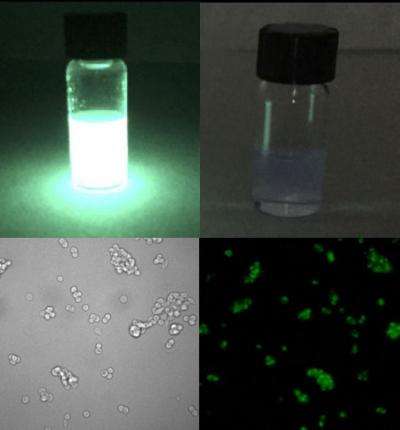A bright 'glow stick' marker for cells

Any child who has played with a glowstick or captured a firefly understands the wonder of chemiluminescence, or chemical light. This process is already used to detect blood at crime scenes and to determine the concentrations of different components of biological samples. This week in ACS Central Science, researchers introduce a new chemiluminescent probe that is better for use in water and up to 3,000 times brighter than previous probes.
Chemiluminescent probes are among the most sensitive diagnostic tools for DNA sequencing, crime scene analysis and immunoassays. Most systems use a cocktail with one emitter molecule that detects the species of interest by giving off weak light, and another two additional ingredients—a fluorophore and a soap-like substance called a surfactant—that amplify the signal to detectable levels. However, energy is lost in the transfer process from one molecule to the other, and surfactants are not biocompatible. Doron Shabat and colleagues proposed that by tweaking the electronic structure of current probes to improve their inherent fluorescence, they could create a new single-component emission system that would work for many applications.
The researchers investigated many variants of the most-common emitter molecule by swapping out elements and testing the resulting changes in emission. Shabat and colleagues found that, in one instance, simply adding two key atoms resulted in a much brighter probe than those currently on the market. In addition, this particular molecule is suitable for direct use in cells. Based on this molecule, the researchers developed sensors to detect several biologically relevant chemicals. They also used the chemiluminescent molecule to measure the activity of several enzymes and to image cells by microscopy—something that had previously required the genetic engineering of the firefly's enzymatic machinery. They say that scientists will now have in hand a new powerful methodology to prepare highly efficient chemiluminescence sensors for detection and imaging of various cell activities and analytes.
More information: Opening a Gateway for Chemiluminescence Cell Imaging: Distinctive Methodology for Design of Bright Chemiluminescent Dioxetane Probes ACS Cent. Sci., Article ASAP. DOI: 10.1021/acscentsci.7b00058
Journal information: ACS Central Science
Provided by American Chemical Society




















